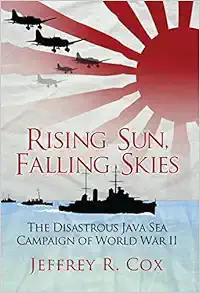
Rising Sun, Falling Skies: The disastrous Java Sea Campaign of World War II (General Military)
Paperback – November 17, 2015
Description
“In the Pacific War's first months, elements of four navies, Dutch, British, American, and Australian, fought a delaying action against superior Japanese forces as heroic as it was hopeless. Cox brings an attorney's incisiveness, a historian's comprehension, and a storyteller's passion to this compelling account of the Java Sea campaign. Rising Sun, Falling Skies commemorates not a defense but a defiance: a forgotten epic of character and honor.” ― Dennis Showalter “As Japanese forces were hitting Pearl Harbor, countrymen undertook to maul the Allies in the Java Sea. That 1941-1942 onslaught, which cost the Royal Navy the dreadnoughts Repulse and Prince of Wales, inflicted a string of defeats unjustifiably accorded short shrift in many histories. Here they receive an informed airing.” ― World War II Magazine “A seminal work about a long neglected part of World War II in the Pacific... richly detailed with accounts from the men on both sides of the conflict who fought desperate struggles in 1942 either as conquerors or defenders.” ― Mike Walling, author of Forgotten Sacrifice and Bloodstained Sea ". . . an excellent read on a topic too often glossed over in general histories and too rarely covered in specific ones." ― Strategy & Tactics Jeffrey R. Cox is a litigation attorney and an independent military historian specializing in World War II, ancient Greece, and ancient Rome. His first interest was in the Pacific War, which he has studied for more than 30 years. A student of history, international affairs, and defense policy for most of his life, Cox holds a degree in National Security Policy Studies from The Ohio State University and a doctorate of jurisprudence from Indiana University School of Law. He is a contributor to Military History Online (www.militaryhistoryonline.com). His first book, Rising Sun, Falling Skies , about the disastrous Java Sea campaign was published to great acclaim in March 2014. He resides in Indianapolis, IN.
Features & Highlights
- Few events have ever shaken a country in the way that the Japanese attack on Pearl Harbor affected the United States. After the devastating attack, Japanese forces continued to overwhelm the Allies, attacking Malaya with its fortress of Singapore, and taking resource-rich islands in the Pacific - Borneo, Sumatra, and Java - in their own blitzkrieg offensive. Allied losses in these early months after America's entry into the war were great, and among the most devastating were those suffered during the Java Sea Campaign, where a small group of Americans, British, Dutch, and Australians were isolated in the Far East - and directly in the path of the Japanese onslaught. It was to be the first major sea battle of World War II in the Pacific.





